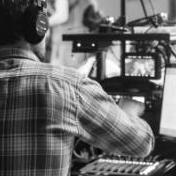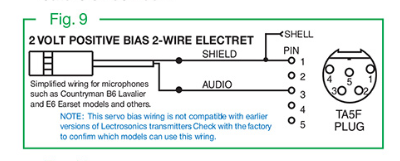-
Posts
347 -
Joined
-
Last visited
About Fernando
- Birthday 01/27/1968
Profile Information
-
Location
Barcelona, Spain
-
Interests
Sound. Music. Musical anthropology. Electroacoustic music composition. Pre 1980 synthesizer circuits. Electronics. Nature. Cooking.
-
About
Location sound recordist for film, TV, documentary, commercial and music. Based in Barcelona, Spain.
Composer. -
Interested in Sound for Picture
Yes
Contact Methods
-
Skype
fdi_recording
Recent Profile Visitors
1,783 profile views
-
Fernando started following Lectrosonics wiring for a Deity w.lav Micro lavalier?
-
Thank you Vincent. It matches Lectro "compatible" "2V positive BIAS, 2 wire" (fig.1, just slightly different resistors), so I guess it could be also wired as "servo" "2V positive BIAS, 2 wire" (fig.9)... with signal to pin 3 and shield to pin 1. --> Anyone tried?
-
Thank you Mobilemike, I assumed the NOTES field was present on a file's metadata edit view, what I said is that it was missing on the main screen, above the meters (when used on a tablet of course, on phones main screen does not show current/next file SCENE/TAKE/NOTES) I only found one video showing Wingman in action with a MixPre, it was from SoundDevices and on the main screen the NOTES field is missing. On this video, when it links to the MixPre, the NOTES field disappears, and also SCENE/TAKE changes to NAME/NUMBER. If this is still true, I beg SD to make possible to switch between SCENE/TAKE/NOTES and NAME/NUMBER _.II._
-
Thank you sir, glad to know. it was missing on the Triptorial video I found and could not find another source
-
AFAIK no sound reports from Wingman for MixPre recorders; this feature is enabled on Wingman for 6xx recorders only. Concerning metadata enter/edit: I see that on Wingman for MixPres there is no NOTES field on the main screen, just SCENE and TAKE. I'd like to have confirmation on this point please
-
Also, when using external lithium batteries (L-mount, NP1, etc) how good is the MixPre to inform on remaining power? Not easy with lithium because of it's discharge curve... specially difficult if using non L-mount batteries of higher voltage since, whatever the source voltage is, it is converted to 8V by the adapter (Hawkwoods LR-04 / LR-06) or Hawkwoods SD-1 (6V? 8V?) So, it is informative/safe enough when using for instance NP1 batteries externally thru a Hawkwoods SD-1 (sled with Hirose 4 pin)? My NP-1s for instance are at 15.8-16V when just charged. Go down to a plateau at 14.4V in some minutes and stay there for long. Then go down rapidly down to 13V where they are depleted. Will this be represented in a useful way on the power monitoring icon on the display? BTOH, I wonder how long it takes to deplete a 65Wh NP-1 using a Hawkwoods SD-1 on the MixPre-6
-
Interesting option. One could use the Hawkwoods L-mount adapter (to use for instance NP1 on a cup) and this slim 2200mAH L battery (or one of similar size), so one could swap NP1s having the slim L-mount acting as a backup while swaping. Would this work or I'm missing something? maybe the recorder will be using both batteries all the time so the small battery will be almost depleted when swapping the external (NP1) battery being of no use to hold the recorder on while swaping...? Can anyone check please?
-
No, it is simply assigned to two destinations. On Deva, Fusion, etc you assign any source to any destination. One source can be assigned to many destinations if needed (one input to many tracks for instance or one track to many outputs, etc) On 633 it could not be done on ISO tracks unfortunately (since they are hardwired to their tracks), but it could be done with mix or aux tracks as destinations I guess (IF "phase inversion while assigning" would be implemented, of course)
-
>will post a pic some time soon when I get a chance to catch a breath for a moment. Tom That would be great : )
-
Thanks Paul, that's really great!
-
>where would you invert the phase of S? Where it needs to : ) just look at the little diagram I did. You assign a source to a destination but phase inverted. I'm not saying you can do that with current SD recorders (that's the point), I'm suggesting SD to switch from "declaring" an MS pair to simply allow for phase inversion when assigning, so you can do it all
-
>It's easy to do on either device. But by implementing it that way you can decode any source anywhere without rigid MS declarations for recording or monitoring. And you can invert the resulting LR (to RL) very simply (by phase inverting on the other S destination), for when you have your MS pair turned 180 degrees (you suddenly have to boom from below) or you are micing counter axis re. camera. And you can decode MS, Double MS and (iirc) B-Format. So it is simpler, computationally cheaper, versatile and works for anything (recording, monitoring)
-
Yes, that's the only thing that is needed. I do it constantly on Deva for many years (and anywhere, ProTools, physical mixing console permitting that kind of routing, etc) You don't need to split the signal. You are already assigning each source signal to two tracks or two outputs or headphone's LR. You assign M source to both destinations and assign S source to both destinations also but the one becoming R has to be phase inverted. This way you generate the decoded L as the sum (M+S) and the decoded R as the difference (M-S). So it is just a matter of being able to invert the phase of a source at the time of assigning it to a destination. It is the most elegant (simplest and most computationally cheap) way to implement MS or double MS. ......1....2 M...x....x S...x....H horizontal: destinations 1 and 2 (tracks, outputs or LR headphones) vertical: M and S sources (inputs or tracks) x: assignation matrix node H: same but phase inverted "1" will become decoded L (m+s), "2" will become decoded R (m-s) The only thing needed is controlling both sources (M and S mics) with one fader for convenience (either if you decode to tracks or only to headphone/outputs while recording the discrete M and S signals), which is already possible.
-
What about correcting metadata after recording? Possible? Easy using a keyboard?
-
They should implement MS decoding in the most elegant way, which is the simplest: implement phase inversion for any channel, both on input-to-tracks and headphone selection, like on Deva. This way you implement MS decoding for recording OR monitoring anywhere you need, on ANY two channels, for MS or double MS. For instance, if you want to record discrete M and S signals, you send the two sources to their tracks and for LR stereo monitoring (or output) you assign M mic to LR and S mic to L and inverted phase R. If you want to record decoded, you send M mic to, say, tracks 1 and 2, and send S mic to track 1 and with phase inversion to track 2 and just monitor LR stereo, since it's already decoded. Is that simple. They just need to implement phase inversion of a source when assigned to a track or an output (headphone or physical) Please, oh please. That's the best way. Simple, versatile, elegant
-

Zaxcom Nomad - operating questions, plus tips & shortcuts
Fernando replied to Jack Norflus's topic in Equipment
Thank you, I just found out. I submitted a register application, hope to access the forum soon. I own a Deva V for some years and was only using the old forum and didn't know about the new one...! Hope I can access the file on time!







